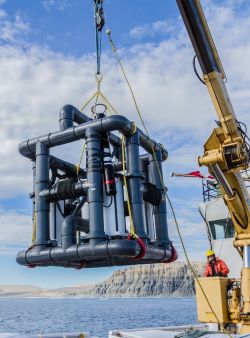NGAS-2440 - Next Generation Autonomous Systems NATO Joint Research Project
Next Generation Autonomous Systems (NGAS) was a NATO Joint Research Project with the objective to developed embedded signal processing,
in-sensor classification, tracking, data fusion, and networked underwater communications and then implement these developments in support of networked autonomous ASW exercises. [1]
Omnitech Electronics has made significant contributions to DRDC's NGAS sensor platforms, sea trials and testing. We have been developing hardware and software for NGAS through various projects since 2007. We continue to support this initiative through our own product development and similar follow-up programs such as CAUSE, and DNA. During NGAS support, Omnitech Electronics engineers participated in more than twelve national and international sea trials. We design sensors and processing electronics for three new sensor platforms and developed embedded software implementations for acoustic network communications, algorithm testing, data collection and autonomous detection and tracking.
First Generation
The first generation of NGAS was built to be easily assembled, low cost and deployable from small crafts. With a mechanical frame that resembled a triangle prism, the deployable sensor node was dubbed 'Starfish'. Each node had a triaxial magnetometer, e-field electrodes, 3-axis cross-dipole hydrophone array, a single wideband hydrophone, and auxiliary sensors for pressure, temperature, and orientation. A network of nodes could be deployed running with battery-powered, autonomous detection and data recorded. Nodes could also be daisy-chained in a cabled array with a high bandwidth Ethernet connection to a shore-based recording and processing system.
Bigger, Better, Cubed

In its 2nd revision and project continuation, the NGAS sensors nodes grew in size and shape, received a processor update, and were able to reuse many Starfish sensors. This revision made use of repurposed sensor frames shaped as cubes but kept the 'Starfish' moniker and they were nicknamed 'Starfish-Cubes'. The cube frames were simple to manufacture from standard PVC pipe, steel supports and concrete. The cube shape simplified sensor installation and calibration, and the increase in size allowed for additional battery capacity and increased sensor array spacing. Omnitech Electronics designed new processing boards and software updates to make use of the new hardware and to integrate a new beamformer, energy detectors, and acoustic communication messages.
Continued Development
The NGAS project ended in 2017 but the research and development efforts continue under new projects and international collaborations. The sensor platforms have been through two additional mechanical variations and Omnitech Electronics have helped DRDC add new sensors and capabilities including vertical line arrays, directional sub-array, improved orientation and location measurement unit and improved timekeeping through the integration of a chip-scale atomic clock.
The platform software was rebuilt with a modular, distributed framework. The detection, localization and tracking pipeline communicates through the Data Distribution Service for Real-Time Systems (DDS). DDS is widely used in complex systems, naval networks, and as the middleware layer of Robot Operating System (ROS2). The DDS layer in the sensor nodes allows users and researchers to easily monitor, test, debug and expanded the node operations and functions without modifying the base software. The goal of Omnitech Electronics' recent software updates is to promote more rapid development and integration of new autonomous functions.
References
[1] NATO Science and Technology Organization - 2017 Highlights, (2017), NATO
[2] Carmen Lucas, Garry J. Heard, Nicos Pelavas, (2015), DRDC Starfish Acoustic Sentinel And Phase Gradient Histogram Tracking, (DRDC-RDDC-2015-N035),
DRDC.
